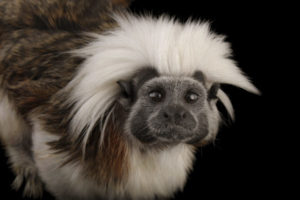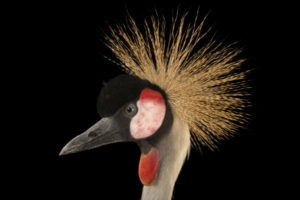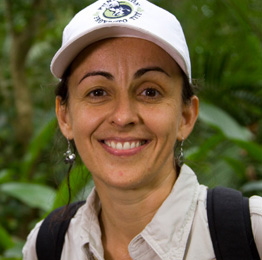Rosamira Guillen National Geographic Award
National Geographic Buffet Awards 2017: Rosamira Guillen and Olivier Nsengimana
Posted by David Maxwell Braun of National Geographic Society in Explorers Journal on June 16, 2017

What do two Endangered enigmatic animals — a majestic wading bird in Africa and an adorable monkey with a shock of white hair in South America — have in common at the National Geographic Explorers Festival? They each have a remarkable champion advocating and working for their survival who have been recognized with the 2017 National Geographic Society/Buffet Award for Leadership in Conservation.
The annual National Geographic Society/Buffett Awards for Leadership in Conservation were established by the Society and The Howard G. Buffett Foundation to recognize and celebrate unsung heroes working in the field. Two awards are presented each year: one for achievement in Africa (established in 2002) and the other for achievement in Latin America (established in 2005).
Meet the 2017 award-winners:
Olivier Nsengimana, a veterinarian and founder of the Rwanda Wildlife Conservation Association, designed a unique conservation project to save his country’s endangered grey crowned-crane from the illegal wildlife trade.
Colombian Rosamira Guillen is executive director of Fundación Proyecto Tití, an organization dedicated to the protection and conservation of one of her country’s most endangered native primate species: the cotton-top tamarin.
National Geographic Voices met with Nsengimana and Guillen during this week’s National Geographic Society Explorers Festival in Washington, D.C. We were curious to know what they had in common and how they may learn from one another, and how the rest of the world may learn from them.
David Braun: Each of you has been inspired by a particular animal to go on to advocate and work for the greater cause of protecting their natural environment. How did those animals come to play such an important role in your life?

Guillen: The cotton-top tamarin has very shocking white hair, crazy Einstein-style hair. That’s the feature everybody remembers it by. But what really shocked me about it as a species is that it is found only in the very northern part of my country, Colombia, and that it is Critically Endangered. That’s what really motivated and impressed me, not coming from a science background, to get involved, change my career so that I could devote my professional life to doing something about saving these species.
Nsengimana: My inspiration came from training to be a veterinarian, mostly in the livestock industry. I interned with Gorilla Doctors, working for mountain gorillas, and became inspired by doing something for a Critically Endangered species, a good cause. I realized that this was me, what I wanted to do for the rest of my life. As I worked with them, and started studying for my Master’s, I realized that the species I grew up with, the grey crowned-crane, a beautiful bird that I used to see in wetlands when I went to fetch water, were no longer there, and no one was doing anything to help them. So that’s when I decided to do something to help make sure that this species did not become history in my country.

An East African crowned-crane, Balearica regulorum regulorum, a subspecies of Balearica regulorum at Parc des Oiseaux Bird Park in France. Photograph by Joel Sartore for the National Geographic Photo Ark. Click on the photo to learn more about Photo Ark.
So both of you have latched on to a specific species that you are using almost as an icon or a big flag to encourage people to be aware and help care for the greater ecosystem?
Guillen: That’s exactly correct. That’s the link we make in all of our awareness programs with people and communities and the general audience, that the animal is a symbol, an ambassador, a spokes-species, for the whole ecosystem that is threatened, and if you save forests for these species, you save the forest for many other species of the wildlife of Colombia– and the benefits that the forests provide to people, like water, food, shelter. We try to make that connection, but the charismatic species is a good way to generate attention and interest in every audience. The fact that is found only in this very little corner of one country…
Nsengimana: Yeah, it’s the same for the grey-crowned cranes. These birds rely on wetlands for survival, and with such an increase in human population in our country, and the demand for more food, a lot of wetlands are being transformed for agriculture. In addition, there is a trade where people want them for pets, something nice for their garden. In my country, owning a crane is seen as a symbol of wealth and longevity, so many people want to have that status.
When we say we are saving the cranes, it is really that we are saving a whole ecosystem, because if we can save the cranes in their own habitat we are also saving so many other species, like amphibians and reptiles that rely on the same habitat. There are also ecosystem services, like water from wetlands and carbon sequestration. We try show people that saving the birds provides services for people. We try to give people ownership and pride in saving this bird in its ecosystem.
Braun: Is the crane the national bird of Rwanda?
Nsengimana: No, it’s the national bird of Uganda. But in Rwanda it used to be a tradition that families were associated with specific animals. So the crane is a family bird for several families in Rwanda. My family, for example, used to have the wagtail as its bird. Other families had cranes, while some other families had animals such as frogs. When we were young the respect we showed for our friends and their families extended to respect for the animals associated with those families. If my friend’s family animal was the leopard, I would not think or do any harm to a leopard, out of respect for that family. It was a nice concept for conservation.
Braun: How about in Colombia? Is there also an affinity with animals?
Guillen: Yeah, but it’s more a lack of awareness that leads people to buying from wildlife traffickers species that are beautiful and different, so that you can brag that you have a pet no one else has. The cotton-top, because of its beauty and the lack of awareness that it is found only in this small region, drives part of the traffic. One of the things we are working on is just creating enough awareness that it takes for people to understand that this animal can become a symbol of Colombian biodiversity, because it is found only in this country, so it is our responsibility to care for it and protect it. It’s the only place in the world where you can find this cute, crazy little monkey.
Braun: It sounds like you’re both trying to turn exotic pets into national symbols of wildlife.
Guillen: Once you know and understand the cultural value, the biodiversity value of a species, you’re more prone to do something about it. If you create the right conditions then that can happen, especially for those who hunt the animal. There is an economic issue there, generating an income from that, so it’s hard work. But you have to find alternatives for these people to make a living in a way that doesn’t harm the environment. That’s part of the community work we do, to reduce the threat and then reduce the purchase. Try to work on both ends, where we see people buying animals and, in the rural areas, people hunting the animals for sale.
Braun: You did not know one another before winning the Buffet Award, but are you already discussing how you can help one another?
Guillen: We’ve been listening to each other, reading about the other.
Nsengimana: There are pretty similar issues, but we are listener to one another to see what we can apply to our situations.
Guillen: Meeting conservationists from different parts of the world makes you realize the challenges are the same, although you really need to take into account the context in which you work — some things work, some things don’t. But it’s great to see hoe creative people get around the world trying to approach the same issue, and you really learn from one another, and that has an amazing value.
Braun: We have heard from other explorers and projects, such as in the case of Pristine Seas, there is real economic value in creating special zones to protect wildlife and wild places, so that instead of there being a sink there can be places where wildlife can flourish and replenish adjacent areas. Those areas can also be sources of economic value, providing eco-services, not only in wetlands and canopies, but also in the form of eco-tourism. Do you think working to protect your special species can also create new opportunities for tourism?
Nsengimana: Yeah, this bird we are working with is iconic and lives in big wetlands. My country is trying to promote avitourism [tourism for birders] because we are really diverse in birds. We are trying to get the government to help with policies so that those communities living near wetlands can both help protect and benefit from ecotourism. We are trying to set up tourism infrastructure and marketing, training guides, even former poachers, training them to manage the whole thing. Research has shown that people who come for the gorillas stay only for a day and a half, see the gorillas and then go to another country. If we could hold them for more days, that’s extra income, money the country is making, and benefits for everyone.
Guillen: Same on our end. Once you create visibility for the species, there is interest in visiting them. So we have to educate to create awareness, and also to generate income for the communities. We aren’t doing this at the moment, but we are seriously trying to understand what it takes, but also finding out how to do it so that it doesn’t affect the habitat, because the cotton-tops are found only in small fragmented habitat. We really need to be careful. It has to be something low-impact and low-scale. But yes, this is something that can really help create a sense of ownership on the part of the local communities.
Braun: How do you fell about receiving the Buffet Award?
Guillen: It is an important opportunity that give us both international visibility for our work, and also nationally, because sometimes we go quietly working, and because there are so many issues in both our countries, wildlife doesn’t get enough attention, and people don’t realize how important it is. Environmental issues are all over the place and affect everything humans do, so
Braun: Both your countries have had troubled pasts, so it’s good to see this kind of work and recognition for the environment.
Guillen: Exactly, and still some of that going on, so biodiversity and environmental issues are at the bottom of the list of priorities, even though by law they are supposed to be on top of the agenda, so this kind of opportunity helps us increase the profile and generates attention, and the visibility and prestige we get from this award from National Geographic means a lot to us, and I know it means a lot to Olivier too.
Nsengimana: It’s exactly what I want to say. For a country like ours, we have had a difficult time, but now we are really stable and trying to grow economically, so there are a lot of priorities. One of the priorities is conservation. We are looking at gorilla conservation to provide funds to deploy to other areas, to other species and ecosystems in need. When they see someone like me being recognized with a great award it’s good because it increases our profile and makes it easier for our work. Collaboration becomes easier. This is really so important for the work we are doing.
Braun: There are no strings attached to the award, but have you thought about what you might do with it?
Guillen: We’ve been struggling to find enough funds for a census of the cranes. The numbers we are using are based on estimates. We are going to hire a helicopter to do an aerial survey, but then do some ground surveys as well in some small fragmented areas.
Nsengimana: We want to build a research station to study the cotton-tops on a property we have, that can also serve as place where children can visit and see the research. It can also be a place where we can habituated= tamarin groups so that we can bring people in and generate this awareness we are hoping for.
Biographies
 Dr. Olivier Nsengimana is a Rwandan veterinarian who designed and implemented a unique conservation project to save his country’s endangered grey crowned-cranes by working to abolish their illegal trade. Nsengimana began the project in 2014 after winning the Rolex Awards for Enterprise–Young Laureate, Environment honor for his efforts to protect this amazing species.
Dr. Olivier Nsengimana is a Rwandan veterinarian who designed and implemented a unique conservation project to save his country’s endangered grey crowned-cranes by working to abolish their illegal trade. Nsengimana began the project in 2014 after winning the Rolex Awards for Enterprise–Young Laureate, Environment honor for his efforts to protect this amazing species.
Nsengimana has since established the Rwanda Wildlife Conservation Association (RWCA), a nonprofit dedicated to expanding research and conservation projects connected to endangered or threatened species in Rwanda, including the grey crowned-cranes. Founded and run by Rwandans who come from and understand local communities and their challenges, RWCA provides a holistic, multidisciplinary approach to critical conservation issues in order to create sustainable solutions.
To combat the threats to grey crowned-cranes, RWCA works closely with the Rwandan government and other partners to raise awareness about their conservation status and the laws protecting them. RWCA also identifies and bands captive cranes; removes them from captivity with the hope of reintroducing them to the wild; and cares for those too ill or disabled to return home. In addition, RWCA engages with local communities to enforce the laws protecting wildlife and to find alternative livelihoods to illegal trading.
Rwanda is a small country with incredible biodiversity, but it is challenged by high population density and extreme poverty, resulting in resources and land being overstretched and significant competition between people and wildlife. The grey crowned-crane (Balearica regulorum) is the only species of crane in Rwanda. Despite being a symbol of wealth and longevity in Rwandan culture, the crane faces increasing threats due to habitat loss and growing illegal trade. Over the last 45 years, it is estimated that the grey crowned-crane’s global population has declined by as much as 79 percent, leaving approximately 300 to 500 in Rwanda.
Nsengimana was inspired to work toward saving cranes and other species in his country and to promoting the beauty and diversity of Rwanda’s nature after growing up in a country devastated by genocide. “Every Rwandan has had a role to play in moving forward from the genocide,” Nsengimana said. “I knew that whatever I did with my life, I had to contribute something meaningful to my country.”
Prior to founding RWCA, Nsengimana worked for Gorilla Doctors as a field veterinarian, providing life-saving veterinary care to critically endangered wild mountain gorillas. He also worked for the PREDICT program, a worldwide effort to build an early-warning system for emerging pandemic threats that move between wildlife and people.
Nsengimana received a master’s degree in veterinary sciences, conservation medicine from the University of Edinburgh and has completed a field-based course in animal health interventions sponsored by the Zoological Society of London, Wildlife Institute of India and the University of Edinburgh. In 2016, he was a finalist for the Tusk Conservation Awards.
 Dr. Rosamira Guillen is a Colombian landscape architect and environmental designer-turned-conservationist. She cofounded and is now executive director of Fundación Proyecto Tití, an organization dedicated to the protection and conservation of one of Colombia’s most endangered native primate species: the cotton-top tamarin.
Dr. Rosamira Guillen is a Colombian landscape architect and environmental designer-turned-conservationist. She cofounded and is now executive director of Fundación Proyecto Tití, an organization dedicated to the protection and conservation of one of Colombia’s most endangered native primate species: the cotton-top tamarin.
After training as an architect and pursuing a master’s degree in landscape architecture at the State University of New York in Syracuse, Guillen was hired to design and implement a remodeling master plan for the Barranquilla Zoo in her hometown of Barranquilla, Colombia. In 2001, she was named director of the zoo. It was through her work there that she learned about wildlife issues and discovered cotton-top tamarins, a species native to northern Colombia that is critically endangered due to deforestation and the illegal pet trade.
“Even though I was always interested in nature and the environment, I didn’t know much about wildlife,” Guillen said. “I couldn’t believe that this primate species was only found in this region of my country and that, growing up, I had never heard about how special and important cotton-tops were for our biodiversity and for the conservation of their tropical forest home.”
As director of the zoo, Guillen prioritized awareness and education efforts to support cotton-top tamarin conservation, highlighting wildlife issues and the challenges that Colombia’s native species face due to the impact of human activities. Guillen’s team built a new exhibit for the tamarins and conducted awareness, media and education campaigns for the zoo’s visitors and local schools to draw attention to the charismatic primate.
In 2004, Guillen cofounded Fundación Proyecto Tití, a Colombian non-governmental organization created to lead conservation efforts on behalf of cotton-top tamarins and their forest home. Initially volunteering as executive director, she joined the organization full-time in 2008.
Fundación Proyecto Tití has raised the profile of cotton-tops in Colombia and abroad while increasing the reach and scope of its conservation efforts. During Guillen’s tenure, Fundación Proyecto Tití’s research led to the International Union for Conservation of Nature classifying the cotton-top tamarin as “Critically Endangered” in 2008 and as one of the “World’s 25 Most Endangered Primates” in 2009. The foundation also helped stop construction of an airport in critical cotton-top habitat; supported the designation of forest protected areas and creation of a biological reserve to protect cotton-tops in perpetuity; and established conservation agreements with 26 local landowners in 2016 alone.
Guillen also developed innovative projects to support the local communities living near cotton-top tamarin habitat. These include educational programs; teaching community members to use fuel-efficient stoves; and working with local women to create and sell tote bags made from recycled plastic bags found in the forest.
“Our intention is to protect cotton-top tamarins and guarantee a long-term future for this species,” said Guillen. “We want to make cotton-tops a symbol of Colombia’s biodiversity and thus generate pride in supporting the conservation of this amazing animal.”
Guillen’s many awards include the 2015 Whitley Award from the Whitley Fund for Nature and a Fulbright Scholarship from 1991 to 1993.
Recipients of the National Geographic Society/Buffett awards have demonstrated outstanding leadership in managing and protecting the natural resources in their regions and countries. In addition, they are each inspirational conservation advocates who serve as role models and mentors.
Award recipients are chosen from nominations submitted to the Committee for Research and Exploration, which screens each nominee through a peer-review process. The awardees chosen each year are honored at a ceremony in Washington, D.C., and receive a one-time grant of U.S. $25,000 to support their ongoing work.
#NatGeoFest
Want to become a National Geographic Explorer? Learn how you can apply for a grant from the National Geographic Society.
Post a comment
Name:*
Email:*
Location:
Comment:
About This Blog
Every hour of every day, somewhere on Earth, National Geographic explorers are at work trying to uncover, understand, or help care for some small part of the world around us.
These are some of their stories.
Subscribe to Voices for Wildlife


